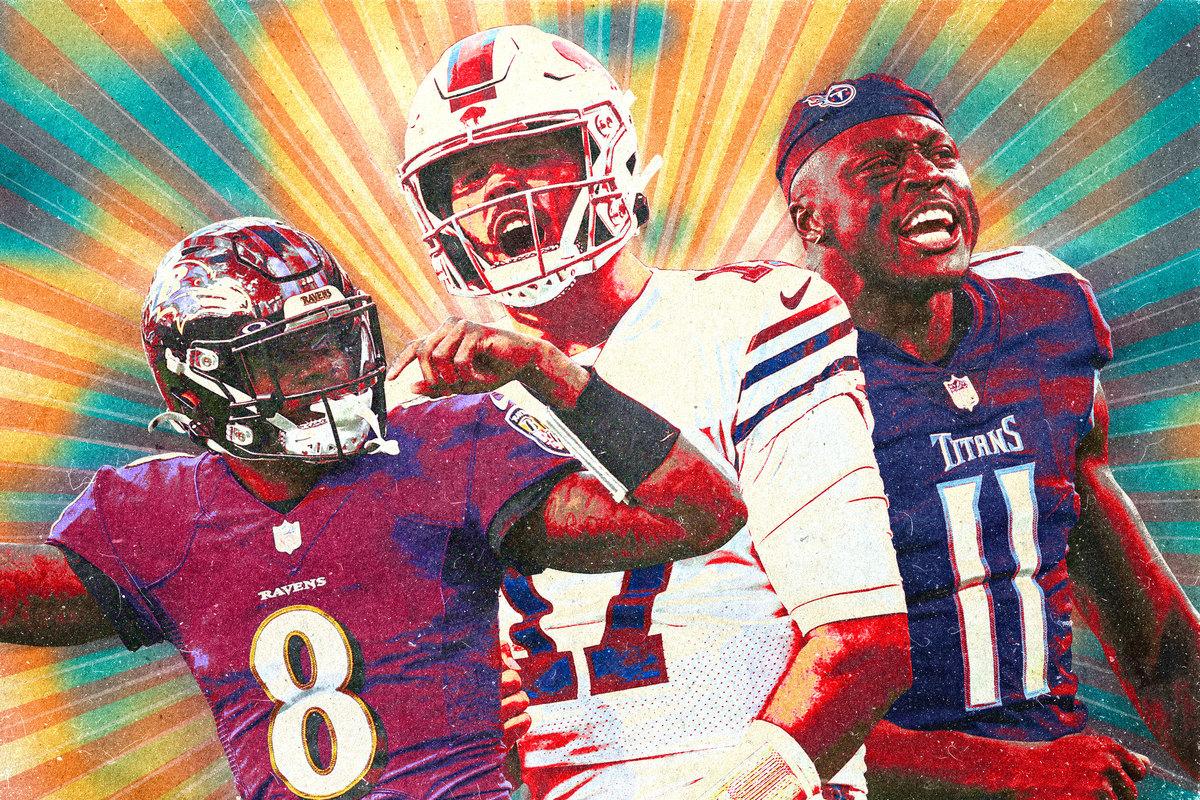
Mike freaking White. The AFC picture was already murky enough heading into what looked like a fairly boring Week 8 slate before White, making his first NFL start, lit up the Bengals in a shocking 34-31 Jets win.
That wasn’t the only upset in the conference on Sunday. Ben Roethlisberger mustered just enough arm strength to pull out a 15-10 win in Cleveland, packing the AFC North race even tighter than it was coming into the week. Then the Patriots ran over the Chargers defense in a convincing 27-24 win in Los Angeles, which kept New England in the AFC East race and solidified the idle Raiders’ position at the top of the AFC West.
After the dust settled on Sunday, there were 10 teams in the AFC with a .500 record or better—and that doesn’t include the defending conference champion Chiefs, who will attempt to join that group on Monday night against the Giants. With only two games separating first place (currently held by Tennessee) and 10th (Denver), the AFC is wide open. But that doesn’t mean there isn’t a clear divide between the teams that have a shot at making Super Bowl LVI and those that will have to settle for a bit part in the postseason chase.
So let’s take a look at the three teams that truly belong in that first group before exploring why the others fall just below the cut.
1. Buffalo Bills (5-2)
According to Pro Football Focus’s betting model, the Bills would currently be the betting favorites against any AFC team on a neutral field. That tells us the same thing that the advanced metrics and the eye test do: that Buffalo is the best team in the conference.
The Bills are certainly the AFC’s most balanced team. They’re the only one in the conference that ranks in the top half of the league in pass and rush DVOA on both sides of the ball. And that balance has helped Buffalo compile the best point differential in the league, even as it sleepwalked through the first half of a 26-11 win over the Dolphins on Sunday.
The Bills are good in ways they weren’t a season ago: The defense has been in a class of its own, and the run game has been more efficient than it was in 2020. Yet this team doesn’t feel nearly as intimidating as it did at this time last year. That’s probably due to the fact that the passing game, which has dropped from third in DVOA to 10th year-over-year, hasn’t been as efficient. Sure, the big plays are coming just as frequently—the Bills’ explosive pass rate is holding steady at 10 percent, according to Sharp Football Stats—but we’ve seen a bit of a decline in the short passing game. According to Sports Info Solutions, the Bills led the NFL in success rate on short dropbacks in 2020. This year, they’re down to a league-average 16th.
The biggest factor in that decline is a dip in accuracy from Josh Allen. Allen ranked eighth in on-target throw rate on short dropbacks last year, and he’s down to 26th this season, according to Sports Info Solutions. That’s a concerning development, but not necessarily a surprising one. Accuracy had been the biggest issue in Allen’s game before his breakout in 2020, and it’s popping up once again. The 25-year-old hasn’t fully regressed to his pre-2020 levels, but he does seem to be somewhere between what we saw in the first two years of his career and what we saw last season:
Josh Allen’s Accuracy
Allen’s lack of accuracy isn’t a major issue by any means, and Bills offensive coordinator Brian Daboll is offsetting the slight decline by dialing up more shot plays off play-action, where Allen has maintained his efficiency:
Josh Allen on Play-action Passes
More play-action could help close the gap between last year’s passing attack and this year’s. But even if the Bills leave things unchanged, they look like the best team in the conference. Losses to the Steelers and Titans should give other teams hope that they can catch up, but Buffalo has largely been running through the easy part of its schedule, winning games by an average of 26 points. Good teams beat up on inferior opponents, and no team has done a better job of that than the Bills. Plus, there is still plenty of room for improvement in the passing game, the most important facet for any team. The Buffalo team we see in January could look very different from the one we’re seeing right now. And that should be a scary thought for the rest of the AFC.
2. Baltimore Ravens (5-2)
The drop-off from Buffalo to the rest of the conference is steep, but Baltimore is my pick as the top threat to the Bills. That’s for two reasons: (1) Lamar Jackson has taken another step as a passer, and (2) the defense can’t play much worse than it has in the first half of the season.
You already know how special Lamar is, so let’s focus on the second part. Most of Baltimore’s defensive issues can be traced back to the season-ending knee injury Marcus Peters suffered in training camp. That news got kind of lost in that wave of injuries that washed over Baltimore in August, but Peters’s absence has had a massive impact on the defense, which has dropped from ninth in defensive DVOA last season to 20th this season.
Peters’s replacement, Anthony Averett, has been picked on a lot this season. Coming into Week 8, Averett was the NFL’s most-targeted cornerback, and he had surrendered a league-leading 477 yards in coverage, according to Pro Football Focus. The 2018 fourth-round pick has been especially vulnerable when the Ravens blitz—he’s been targeted 25 times under those circumstances and allowed just under 10 yards per target and a 60 percent success rate, according to Sports Info Solutions.
Because of that, defensive coordinator Don “Wink” Martindale has had to dial back his blitz calls, which have been a staple of Baltimore’s defense going back to 2019. The Ravens’ blitz rate is down 10 percentage points from last year, according to Sports Info Solutions, and down 17 percentage points from 2019, when both Peters and all-pro safety Earl Thomas were starting in the secondary. (Not that the unit has been very effective when it has sent extra rushers: After giving up 0.02 EPA per play on blitzes a season ago, that number has jumped to 0.23 in 2021.) But here’s some good news: At this same point in 2019, the Ravens were in a similar spot. That defense also ranked 20th in DVOA through eight weeks and needed some upgrades. And general manager Eric DeCosta swung a season-altering trade at the deadline for Peters that helped spark a turnaround.
A cornerback of Peters’s caliber may not be available this time around, but we’ve seen DeCosta pull off minor miracles in the past. If the Ravens can swing a deal for a corner, or if Averett builds on a stellar Week 7 performance against the Bengals, Martindale can get back to blitzing quarterbacks at a league-high rank. That, in combination with an offense that is back to full strength after rookie receiver Rashod Bateman’s return to the lineup last week, could be enough to help Baltimore challenge Buffalo for home-field advantage.
3. Kansas City Chiefs (3-4)
I can’t quit them. Yes, I know how irrational it is to put this very flawed team on the short list of contenders, especially after basically writing its eulogy just last week, but until the Chiefs are mathematically eliminated, I’m not giving up. Besides, it’s not like their road back to the playoffs is all that daunting. A win over the Giants on Monday Night Football would pull Kansas City within a game and a half of the AFC West–leading Raiders. And with two matchups against Vegas left on the schedule, the Chiefs still have full control over their destiny.
When it comes to turning around a season, an offense that’s moving the ball at a historic pace is not a bad place to start. As much as we’ve panicked about the Chiefs, that cannot be overlooked:
The Week 7 loss to the Titans notwithstanding, Patrick Mahomes and this offense have been wildly effective this season … at least, when they haven’t been turning the ball over. According to Football Outsiders, 25 percent of Kansas City’s drives have ended with a turnover, which leads the league by a wide margin. But I’d be far more concerned about that trend if bad luck weren’t the driving force behind it. You could set their reel of turnovers to “Yakety Sax.” Actually, let’s do that:
Mahomes has been criticized this season for trying to do too much, and he even admitted last week that he’s been pressing to make plays, which has led to some of these turnovers. But it’s not like Mahomes is playing any more recklessly than he has in the past. He’s on pace to set a career-best mark in turnover-worthy play rate, according to PFF. Defenses have just done a better job of capitalizing on those mistakes. Mahomes’s luck should even out over the second half of the season, and more of the Chiefs drives will end in scores. There are still issues with the offense—it desperately needs to find a running game, and it wouldn’t hurt if the recently signed Josh Gordon filled the void at the WR2 spot—but with improved turnover luck, this unit is still good enough to win a Super Bowl.
The same cannot be said of the defense. That unit mostly looks like a lost cause—though if you squint hard enough, you can find a couple of reasons to believe that things could improve over the second half. The front seven has been the main culprit in this nightmarish start, but that group has been missing some key parts. Chris Jones, the team’s best defensive player, missed two games with a wrist injury. Frank Clark also missed time and said this past week that his poor play has been the product of poor health and a divided focus. Willie Gay’s return should add some much-needed athleticism to the linebacker corps. His interception of Ryan Tannehill was one of the few bright spots in the loss to Tennessee last week.
The schedule should also lighten up after a brutal early slate. According to Football Outsiders, the Chiefs have played the sixth-toughest schedule of offensive opponents. The stat nerds tell us that defensive performance is largely a product of the offenses a unit has played, so an easier schedule should lead to some natural improvement. Just how much improvement will determine this team’s ceiling. If it can just play at a mediocre level, Mahomes should be able to drag it to another divisional crown. And if the Chiefs get back to the postseason, anything is possible.
In Limbo: Tennessee Titans (6-2)
I was fully prepared to include the Titans on the short list of legitimate AFC contenders, and then Adam Schefter dropped this bomb on Monday morning:
The “Running Backs Don’t Matter” crowd will say that losing Henry for the season would have a negligible effect on the Titans offense, but there are exceptions to every rule, and I think a 250-pound back who runs like a wide receiver qualifies as an exception. If you require an evidenced-based argument that Henry “matters,” I’ve got you covered. Here’s how the Titans offense has performed this season with the running back on and off the field.
Titans Offense With and Without Derrick Henry
At the very least, Henry’s absence would change the way opposing defenses play the Titans. According to PFF, Tannehill has attempted the 10th-most passes against single-high safety coverages this season, and his 84.9 passing grade on those plays ranks seventh. If defenses don’t have to worry about loading up the box to stop Henry, that will change, and Tannehill will have less space to exploit downfield. The Titans quarterback has preyed on overzealous linebackers vacating the middle of the field in order to defend the run. If defenses aren’t as hell-bent on stopping the run, Tannehill might be forced to make more difficult throws to the perimeter.
Tennessee’s statistical profile, which had been boosted by the league’s second-most-efficient rushing attack, looked shaky even with Henry in the lineup. Despite its AFC-best 6-2 record, the Titans are hovering around the middle of the league in total DVOA thanks in large part to a suspect defense. Now, the defense has shown some improvement over the past month or so, but turnovers have been the driving factor there. While Tennessee ranks 12th in EPA allowed since Week 5, it ranks 31st in success rate, according to RBSDM.com. Sunday’s overtime win over the Colts followed that same general pattern. Indy moved the ball with little resistance, but two ugly Carson Wentz turnovers, as well as a fortunate fumble following a Tannehill pick, swung what probably should have been a loss in the Titans’ favor.
Even with Henry out, Tennessee should cruise to an AFC South title. FiveThirtyEight gives the Titans a 97 percent chance to win the division, so it will take a lot more than one injury to keep this team out of the playoffs. But if Henry is out for the season, that’s probably as far as Tennessee’s going to go.
The Rest of the Pack
Outside of the group we’ve already covered, there are five AFC teams that have at least a 40 percent chance of making the postseason, according to FiveThirtyEight’s prediction model: the Chargers, Raiders, Bengals, Steelers, and Patriots. For each of those teams—plus the .500 Browns, who we’re including here—there’s at least one fatal flaw that’s holding it back from contending for a Super Bowl berth.
Chargers (4-3): The Defense
Brandon Staley has won over the heart of Football Twitter with his impressive press conferences, but those viral sound bites aren’t helping out on the field, where the Chargers defense continues to get gashed on the ground. The Patriots were able to run at will in Sunday’s victory, which ultimately cost Los Angeles a winnable game.
Raiders (5-2): Coaching Turmoil
The Raiders have won both of their games in the post–Jon Gruden era, but head coaching has to matter, right? You have to go back to before the NFL-AFL merger to find examples of an interim coach leading a team to playoff glory, so history suggests this upstart Raiders team will have a hard time keeping its current pace.
Bengals (5-3): Zac Taylor
The flashes have certainly been there for the Bengals offense. But most of their success has been predicated on Joe Burrow’s control at the line of scrimmage and his preternatural connection with former LSU teammate Ja’Marr Chase. There are still fundamental flaws with Taylor’s offensive scheme, which is why such a talented offense is putting up mediocre efficiency numbers.
Steelers (4-3): Ben Roethlisberger
This one shouldn’t require too much of an explanation. Roethlisberger isn’t the lone problem for the Steelers offense, but he is the biggest one. Whether or not the 39-year-old is still capable of pushing the ball downfield, he doesn’t seem too interested in doing so, which makes this group a lot easier to defend.
Patriots (4-4): A Lack of Big Plays
Mac Jones has been everything the Patriots could have reasonably expected. The rookie has been accurate, and he’s done a good job of avoiding negative plays. But New England just doesn’t have the talent to turn Jones’s efficiency into big plays. The only way for the Patriots to score is through long, arduous drives, and that degree of difficulty is just too high for a rookie, even one as advanced as Jones.
Browns (4-4): Baker Mayfield’s Injury
Mayfield may not be capable of carrying an offense on his own, but he has proved capable of leading a highly efficient attack—at least when healthy. Mayfield played well on Sunday against a good Steelers defense, but it’s clear that protecting his injured left shoulder is limiting his play-making ability. He scrambled just once in the loss to Pittsburgh.

